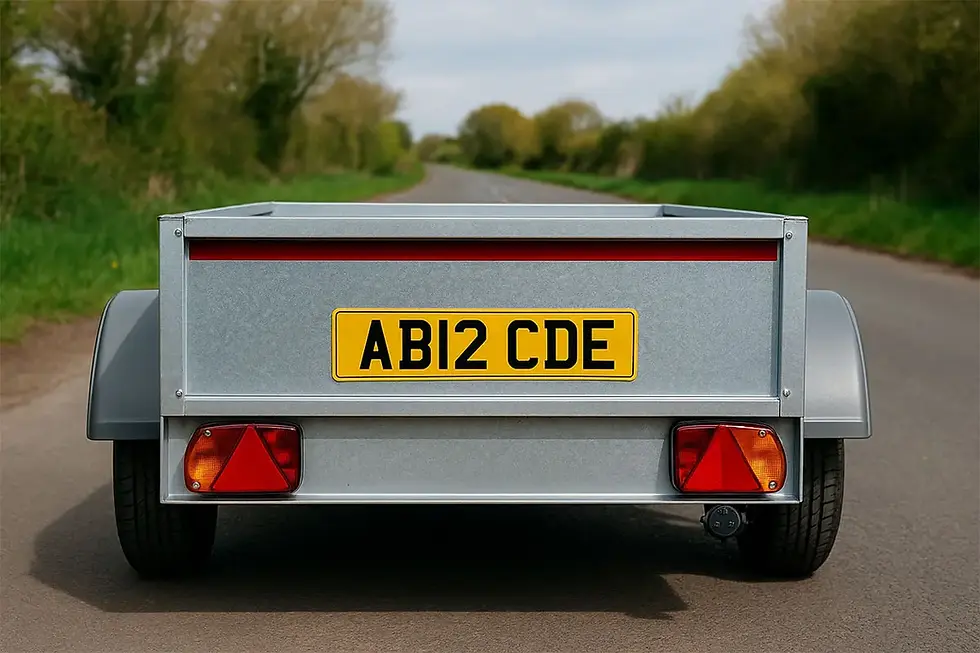Trailer Lighting Requirements: Stay compliant with lights
- Brent

- Oct 4
- 3 min read
Good lighting isn’t just about being seen — it’s the law. Every trailer on UK roads must have the correct lighting setup to make sure it’s visible, identifiable, and safe for both the driver and everyone else on the road.
Here’s a complete breakdown of UK trailer lighting regulations, what’s required, and the small details that make a big difference.
The Basics: Rear Lighting Requirements
Every road-going trailer must have the following rear lights:
Two red sidelights
Two red stop lamps (brake lights)
An illuminated number plate
Two triangular red reflectors
Amber indicators that flash between 60 and 120 times per minute
If your trailer is wider than 1.3 metres, you must also fit at least one red fog lamp. While one fog light is the legal minimum, fitting two — one on each side — provides better symmetry and visibility.
Front Lights and Reflectors
Since 30 September 1990, all trailers must have front reflectors. If your trailer is wider than 1.6 metres, it must also have front position lights (clear white lamps).
These ensure your trailer is visible from the front when parked or approaching at night.
Reverse Lights
Any braked trailer with a gross weight over 750 kg must have at least one reverse lamp on the left-hand side. If your trailer is longer than 6 metres, it must have two reverse lamps, one on each side.
This helps alert other drivers and improves visibility when manoeuvring larger or heavier trailers.
Fog Lamp Rules
Fog lamps are mandatory on any trailer over 1.3 metres wide.
If you fit only one, it must be positioned on the offside (right-hand side) or on the centre line.
If you fit two, even better — they must be spaced evenly and at the same height.
There must be at least 100 mm between the fog lamp and the stop lamp to avoid confusion in brightness.
There’s no maximum distance from the outer edge of the trailer, as long as they are clearly visible.
Height and Distance Requirements
Lighting height rules exist to make sure lights are visible from standard driver sightlines. However, the regulations allow some flexibility if your trailer design makes standard fitting impossible.
Direction indicators: Maximum height can increase to 2,300 mm if necessary.
Tail and stop lamps: Maximum height can increase to 2,100 mm.
Triangular red reflectors: On trailers built after 1 October 1985, the height can increase to 1,200 mm if needed.
For side lighting and indicators, the distance from the side of the trailer must not exceed 50 mm more than that of the rear lamps.
Trailers built after 1 October 1985 must illuminate the number plate using an ‘E’ or ‘e’ marked lamp.
If the rear lamp cluster has an approved clear window, it may be used instead — but only if installed per the manufacturer’s specifications for distance and brightness.
A dim or missing number plate light can lead to a fine, especially in low-light towing conditions.
Side Lights and Reflectors
Certain trailers (particularly long or wide ones) must also have:
Side position lights — showing white to the front and red to the rear
Amber side reflectors — required for longer trailers, improving visibility when crossing junctions or parked at night
Boat trailers are an exception to the front light requirement due to their unique design.
Brent’s Take
At Brent, we know that a properly lit trailer doesn’t just look professional — it keeps you compliant and safe. Lighting regulations can seem like fine print, but every lamp, reflector, and connection plays a part in your visibility and road safety.
Before towing, always check:
Are all lights working and clean?
Are reflectors visible and undamaged?
Is your number plate illuminated?
Are wiring and plugs free of corrosion?
If your trailer’s lighting setup is outdated or unreliable, it’s worth upgrading. You’ll find modern, fully compliant trailers on Brent — built to meet UK standards and ready for the road.
Brent — lighting the way for safer towing.
-Brent




Comments